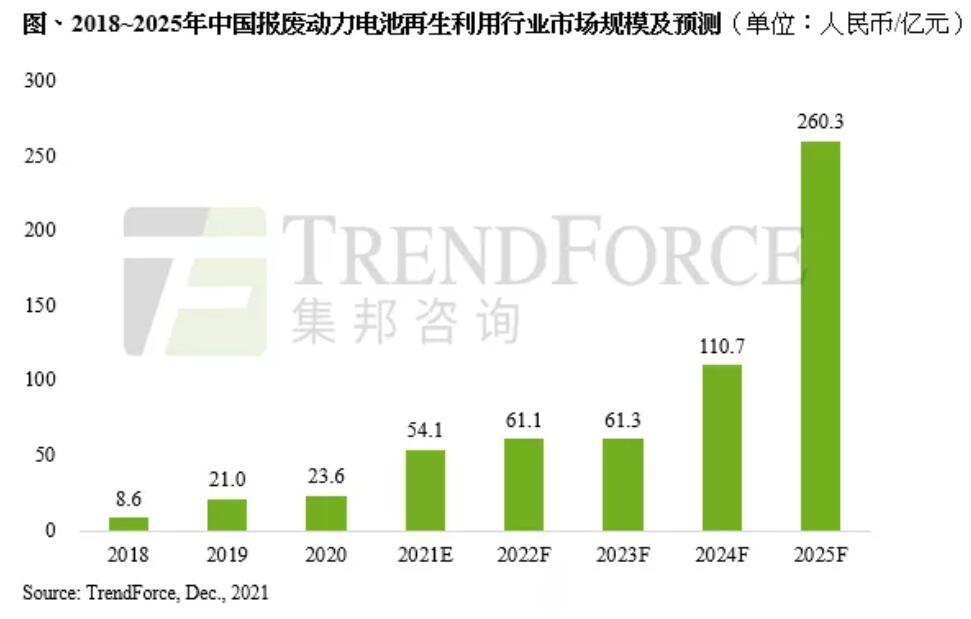The amount of retired power batteries in China is going up year by year, with the scrap volume expected to exceed 18 GWh in 2021 and reach 91 GWh by 2025, according to TrendForce.
With the rapid development of China's new energy vehicle (NEV) industry, the size of retired power batteries is also increasing year by year.
China's used battery recycling market has gained some scale and is estimated to reach RMB 26 billion ($4.1 billion) by 2025, more than 10 times the RMB 2.4 billion in 2020, according to a report released today by market research firm TrendForce.
Power battery retirements in China are going up year by year, with end-of-life volumes expected to exceed 18 GWh in 2021 and reach 91 GWh by 2025, the report said.
At present, the recycling of power batteries is mainly divided into secondary use and recycling. The former is for the batteries to be used in other fields such as power backup and energy storage when the capacity of power batteries decays to less than 80 percent.
The recycling is mainly to recover lithium, cobalt, nickel and other metals from retired power batteries after disassembly.
TrendForce believes that with the rapid development of the NEV industry, large-scale retirement of power batteries can be expected, thus bringing opportunities for power battery recycling and secondary utilization.
At the end of June, China's state-owned broadcaster CCTV highlighted the impending mass retirement of power batteries in a report.
As the power batteries of the earliest batch of NEVs to hit the market came into retirement, the total number of retired power batteries in China reached about 200,000 tons in 2020, according to CCTV.
That figure is expected to rise to about 780,000 tons by 2025, four times the amount in 2020, according to the report.
Power batteries have their own upper limit of service life, and when the capacity decays to 80 percent, they are no longer suitable for car driving use.
The general theoretical life of NEV power batteries can reach 8 years, corresponding to a mileage of 100,000 km, but in actual use, they usually only have a life of 4-6 years.
China ushered in the NEV boom after 2013 and became the number one country in NEV production and sales for six consecutive years starting from 2015 to 2020. According to the upper limit of service life, China has already seen the first wave of power battery decommissioning in 2018.
China's Ministry of Industry and Information Technology recently issued a green development plan for the industrial sector, saying it will improve regulations on power battery recycling, with the goal of building a more complete power battery recycling system by 2025.
China's new battery recycling policy, TrendForce said in a report today, will promote the orderly and healthy development of the lithium battery industry and help break through global constraints on key resources such as lithium.
Leading players in the industry already see potential opportunities arising from future power battery retirements.
CATL, China's largest power battery maker, plans to invest up to RMB 32 billion in Yichang, central Hubei province, to build a power battery material recycling project, the company said in an October 12 announcement.
The investment will be used to build a base to recycle used battery materials and produce materials including lithium iron phosphate and ternary precursors, lithium iron phosphate, lithium cobaltate and ternary cathode materials, graphite and phosphoric acid.
The project is designed to meet its power battery capacity expansion needs, secure battery material supply and advance the company's goal of full lifecycle management of retired power batteries, CATL said.
This is not CATL's first foray into battery recycling.
In 2013, the company entered the battery recycling business through Brunp Recycling, and in 2018, SAIC and CATL entered into a strategic partnership to jointly promote the recycling of NEV power batteries.
As an important subsidiary of CATL, Hunan Brunp is currently the largest recycling base for used batteries in China, with a total of over 6,000 tons of used batteries recycled and processed annually.


